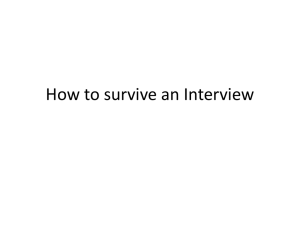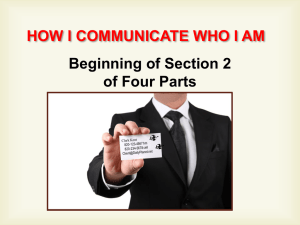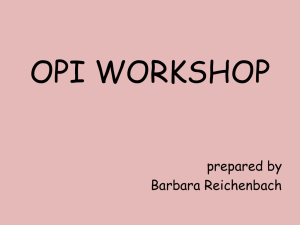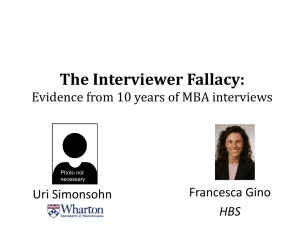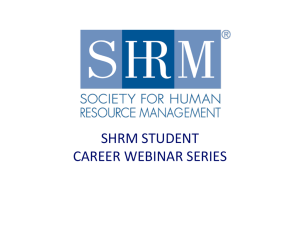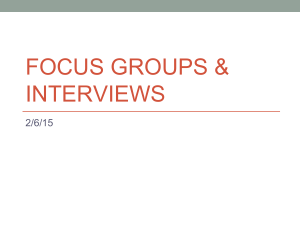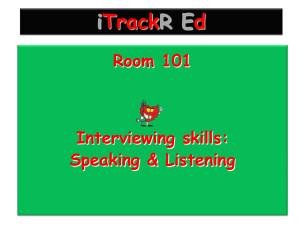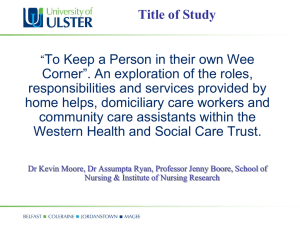Interviewing Skills
advertisement
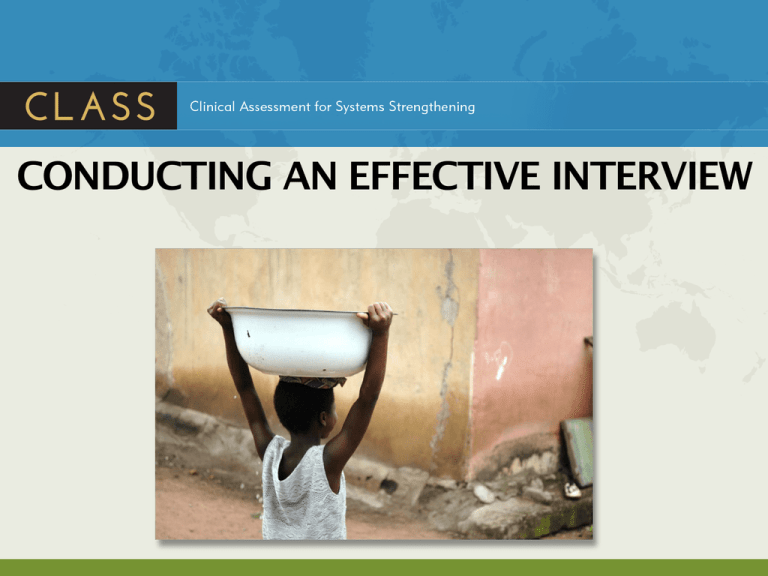
CONDUCTING AN EFFECTIVE INTERVIEW Learning Objectives By the end of the session, participants will be able to: • Define “In-depth Interview” • Describe 3 skills for effective communication • List the qualities of a good interviewer • Identify and describe effective interviewing techniques In-depth Interviews “In-depth interviews are excellent tools to use in planning and evaluating programs because they use an open-ended, discoveryoriented method, which allows the interviewer to deeply explore the respondent’s feelings and perspectives on a subject. This results in rich background information that can shape further questions relevant to the topic. ” Characteristics of In-depth Interviews • Open-ended Questions: Give respondents the freedom to answer questions using their own words. • Semi-structured Format: Interview should be conversational, with questions flowing from previous responses when possible. • Seek Understanding and Interpretation: Interviewer should continually seek clarity and understanding throughout the interview. • Recording Responses: Written notes include observations of both verbal and non-verbal behaviors as they occur, and immediate personal reflections about the interview. www.classtoolkit.org Effective Communication • People like to share with people who are sincere, approachable, and non-judgmental. • These qualities are communicated primarily by facial expressions, followed by tone, and, to a limited extent, by words. • People often remember more about how a subject is communicated than the speaker’s knowledge of the subject. Types of Communication • Verbal – Spoken words • Nonverbal – The way we sit/stand – Facial expressions – Silence Nonverbal – Eye contact – Gestures (smiling, leaning forward, nodding) Effective Communication Techniques (1) 1. Active listening Attending fully to what the speaker is saying by focusing wholly on what is being said. Requires the listener to give full attention to the speaker until either the message has been received or the speaker has finished speaking. Active Listening Effective Communication Techniques (2) 2. Reflective listening: The process of verbally “reflecting” back what someone has said • Helps the interviewer check whether s/he understands the interviewee • Helps the interviewee feel understood and respected Reflective Listening Confirms that you have understood the interviewee by using statements such as: – “So you feel frustrated that there’s not enough time to do a complete physical exam.” – “It sounds like you’re concerned about this patient’s ability to adhere to treatment.” – “So you’re wondering if this training will address the performance gaps you’ve identified.” Effective Communication Techniques (3) • Summarizing: Process of synthesizing and re-stating what the interviewee has said in order to capture key concerns and issues Summarizing • To confirm that you have understood the interviewee’s story or issue • To change topics, close discussion, or clarify something • To collect your thoughts • To show the interviewee that you have heard and respect his/her point of view Listening Activity Qualities of a Good Interviewer • Open-minded • Flexible and responsive • Patient • Observant • A good listener • Friendly www.classtoolkit.org Effective Interview Techniques • Create a rapport • Use open-ended questions • Use probes to go deeper into a subject • Avoid leading questions • Clarify vague or hard-to-understand responses by summarizing or presenting a scenario or example Create a Rapport •Learn culturally-specific styles and techniques for building rapport •Be an engaged listener with a neutral attitude •Tune into non-verbal communication cues and adjust your interviewing style depending on the interviewee •Make eye contact and smile •Ask about family or other appropriate small talk www.classtoolkit.org Open-ended Questions Open • Leave the answer very open to what the interviewee wants to say Closed • Ask for specific answers, such as “yes” or “no” • Results in a long, narrative answer • Quick, easy to answer, give you facts, answer with short word or phrase • Often start with: • Often start with: – “How” – “Do” – “What” – “Are” – “Describe” – “Will” – “Explain” – “How many” – “If” or “Would” ‘Opening up’ Closed Questions • Do you have enough resources for your program? • Is it challenging to learn counseling skills through a computer? • Would you say your Internet is reliable? • Do participants ever drop out of your DL program? • Did facilitators have experience before they taught your eLearning course? Probes • Probes are neutral questions, phrases, sounds, and gestures used to encourage participants to elaborate on their answers • A highly effective way to encourage further sharing without the interviewer imposing him or herself into the narrative • One of the most important tools in in-depth interviewing Types of Probes • Silent • Echo • “Uh-huh” • Long question • “Tell me more” • Summarizing 20 When to Use Probes • Response to your question is unclear/brief • Interviewee seems to be waiting for a reaction from you before continuing to speak • Interviewee appears to have more information on the subject • To get more detail about what the interviewee thinks or feels in relationship to the topic being discussed • To further or confirm your understanding or encourage more explanation Examples of Probes 1. “Can you give me an example of that?” 2. “Please tell me more about . . .” 3. “What exactly do you mean by that?” 4. “How typical is that (occurrence, thing)? 5. “What are some of the other ways to do . . .” 6. “Mmm,....really?”, “interesting…”, “I see…” 7. “Why do you think that is?” Leading Questions • Leads interviewee along a particular line of thinking • Subtly prompts interviewee to answer in a particular way • Risks revealing your own value judgments and biases • Interviewees often provide a response in accord with the question because they are reluctant to contradict the interviewer Examples of Leading Questions • How challenging is it to learn how to diagnose patients using a distance learning method? • Most students with few technical skills will struggle in this eLearning program, is that right? • Was one reason you stopped staffing the telementoring line because the mentors weren’t interested in adding to their responsibilities? • Do you think the reason facilitators don’t follow up with participants is because they don’t have access to a computer or internet connection? Exercise: Observe an In-Depth Interview (1) www.classtoolkit.org Exercise: Observe an In-Depth Interview (2) • What did the interviewer do well? • Discuss how the interviewer phrases questions. • What are some ways the interviewer solicited clarification on answers that were unclear? • When does the interviewer ask open-ended questions? • When does the interviewer follow up interview questions with probing questions? • What could the interviewer have done to improve the quality of information he received? www.classtoolkit.org Interviewing “DOs” • Prepare in advance! Understand purpose of the assessment • Only ask questions interviewees can reasonably be expected to answer • Be thoroughly familiar with informed consent documents and be able to explain them to the interviewee if necessary. • Know the questions well in advance and be able to rephrase or produce follow-up questions and probes • Know the flow of questions so you can adjust the order to match conversation flow if necessary. • Use culturally-specific styles and techniques for building rapport. • Remain neutral and remember that your body language 27 and reactions can convey your own biases. Interviewing “DON’Ts” • Don’t let the interviewee have too much control over the interview • Don’t lead the interviewee based on preconceived notions • Don’t be judgmental toward responses • Don’t ask dichotomous questions (when they can be avoided) • Never tell a participant they’ve contradicted themselves 28 QUESTIONS? www.classtoolkit.org


